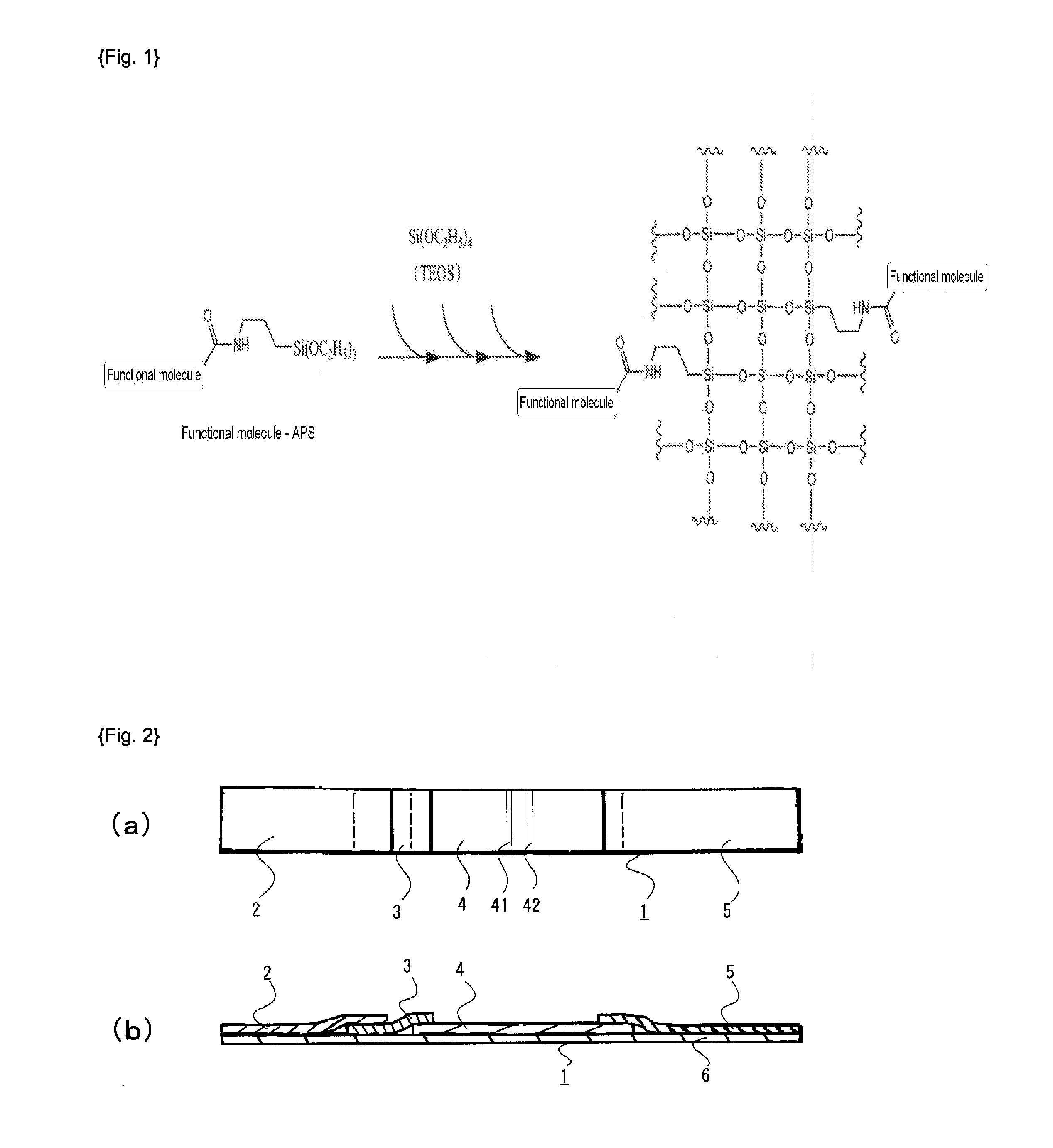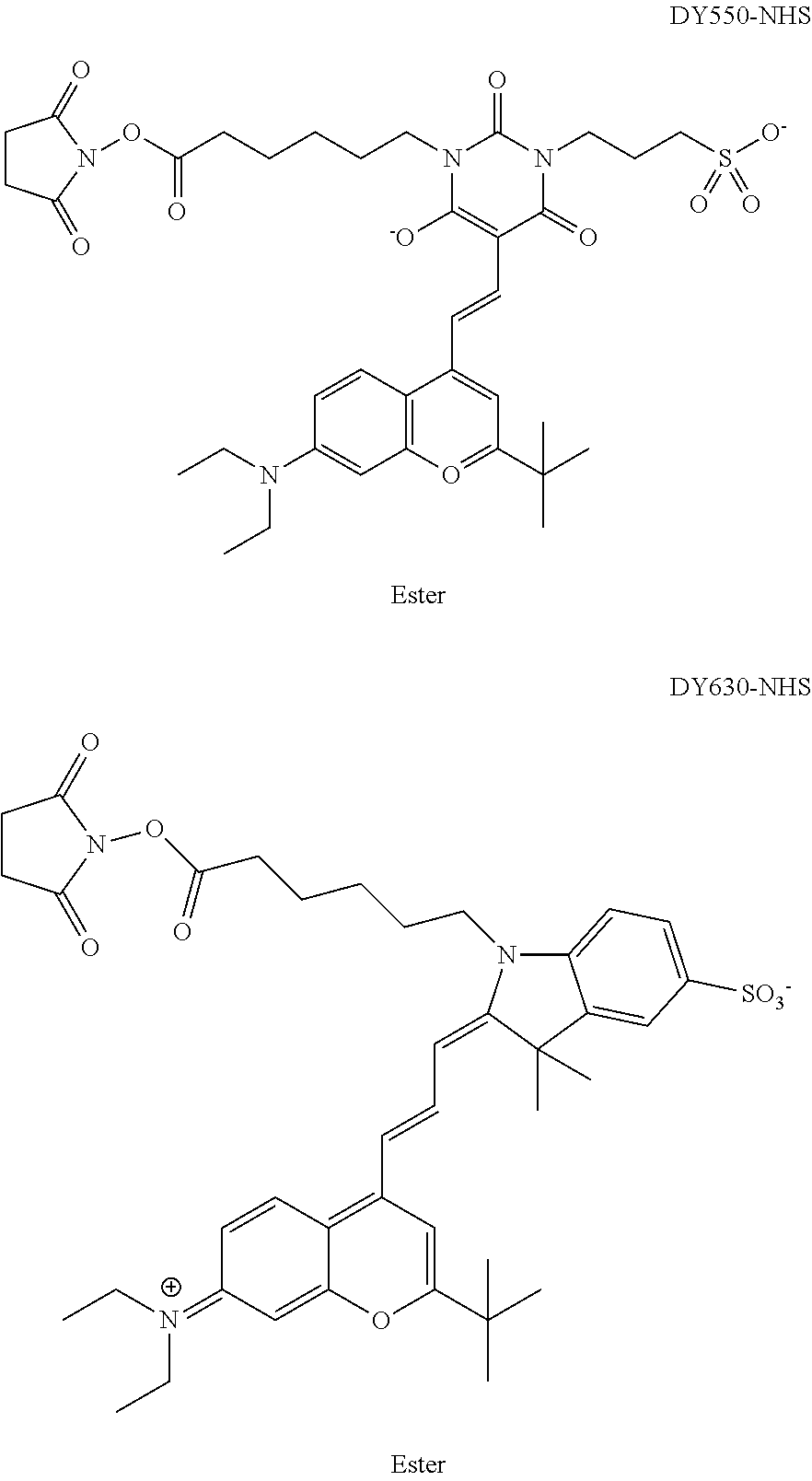Method of producing functional molecule-containing silica nanoparticles on which biomolecules are bonded
a technology of functional molecules and silica nanoparticles, which is applied in the direction of immunoglobulins, instruments, peptides, etc., can solve the problems of poor reproducibility of inspection results using labeling reagents, difficult to keep constant quality of prepared labeling reagents, and limited control of the amount of polymer to be coated, etc., to achieve excellent reproducibility, excellent preservation stability, and high sensitivity
- Summary
- Abstract
- Description
- Claims
- Application Information
AI Technical Summary
Benefits of technology
Problems solved by technology
Method used
Image
Examples
reference example 1
Preparation of Functional Molecule-Containing Silica Nanoparticles Having Thiol Group—1
(Preparation of Functional Molecule-Containing Silica Nanoparticles)
[0098]Silica nanoparticles containing Carboxy Rhodamine-6G being a fluorescent molecule as a functional molecule were prepared.
[0099]Was 3.1 mg of 5- (and -6)-carboxy rhodamine 6G·succinimidyl ester (trade name, manufactured by EMP Biotech GmbH) dissolved in 1 mL dimethyl formamide (DMF). Then, 1.2 μL of APS (manufactured by Shin-Etsu Silicone Co., Ltd.) was added thereto and the reaction was carried out for 1 hour at room temperature (23° C.). Then, 5- (and -6)-carboxy rhodamine 6G-APS composite (5 mM) was obtained.
[0100]Was 600 μL of the obtained solution of 5- (and -6)-carboxy rhodamine 6G-APS composite admixed with 140 mL of ethanol, 6.5 mL of TEOS (manufactured by Shin-Etsu Silicone Co., Ltd.), 20 mL of distilled water, and 15 mL of 28 mass % aqueous ammonia, and the reaction was progressed at room temperature for 24 hours.
[0...
reference example 2
Preparation of Functional Molecule-Containing Silica Nanoparticles Having Thiol Group—2
[0105]Aqueous ammonia of 14 mass % was diluted by 5 times with ethanol, and thus 3.5 mL of aqueous ammonia-containing solvent was prepared. To the aqueous ammonia-containing solvent, 30 μL (135 μmol) of TEOS (manufactured by Shin-Etsu Silicone Co., Ltd.) and 30 μL of 5-(and 6-)Carboxy Rhodamine-6G-APS composite (5 mM) prepared in Reference Example 1 were added, and the resultant mixture was stirred at 40° C. for 30 minutes, and thus a solution in which core particles containing fluorescent molecules was formed (hereinafter, occasionally referred to as a core fluorescent particle-containing solution) was obtained.
[0106]To the above-described core fluorescent particle-containing solution, 30 μL (135 μmol) of TEOS (manufactured by Shin-Etsu Silicone Co., Ltd.), and 11 μL (110 nmol) of 5-(and 6-)Carboxy Rhodamine-6G-APS dissolved into dimethylformamide (DMF, manufactured by Wako Pure Chemical Industri...
example 1
Preparation of Functional Molecule-Containing Silica Nanoparticles on which Biomolecule is Bonded—1
[0111]To 40 μL of dispersion liquid (concentration 25 mg / mL, a dispersion medium: distilled water) of thiol group-introduced fluorescent silica nanoparticles A (mean particle diameter 260 nm) prepared in Reference Example 1, 460 μL of DMF was added, and the resultant mixture was centrifuged at a gravitational acceleration of 15,000×g for 10 minutes. A supernatant was removed, 500 μL of DMF was added thereto, the resultant mixture was centrifuged and a supernatant was removed. Then, 500 μL of DMF was again added to disperse thiol group-introduced fluorescent silica nanoparticles A. In there, 1 mg of 3-maleimidobenzoic acid as a linker molecule was added, the resultant mixture was mixed for 30 minutes, and thus a thioether bond was formed between the maleimido group of the above-described linker molecule and the thiol group of thiol group-introduced fluorescent silica nanoparticles A.
[01...
PUM
| Property | Measurement | Unit |
|---|---|---|
| mean particle diameter | aaaaa | aaaaa |
| diameter | aaaaa | aaaaa |
| mean particle diameter | aaaaa | aaaaa |
Abstract
Description
Claims
Application Information
 Login to View More
Login to View More - R&D
- Intellectual Property
- Life Sciences
- Materials
- Tech Scout
- Unparalleled Data Quality
- Higher Quality Content
- 60% Fewer Hallucinations
Browse by: Latest US Patents, China's latest patents, Technical Efficacy Thesaurus, Application Domain, Technology Topic, Popular Technical Reports.
© 2025 PatSnap. All rights reserved.Legal|Privacy policy|Modern Slavery Act Transparency Statement|Sitemap|About US| Contact US: help@patsnap.com


